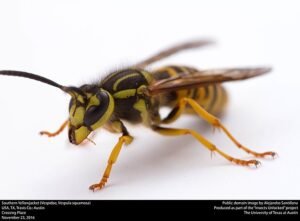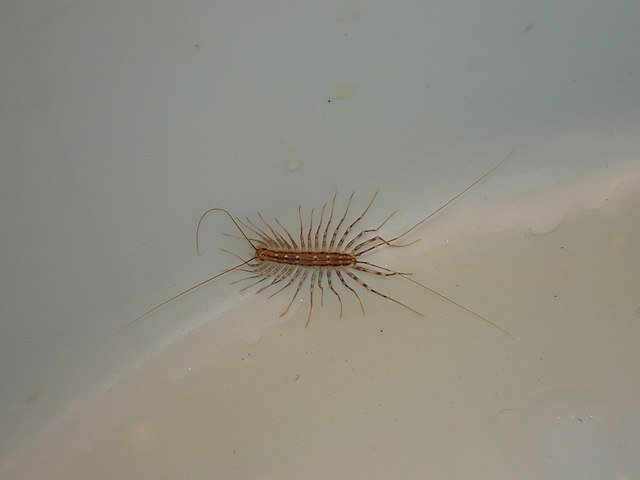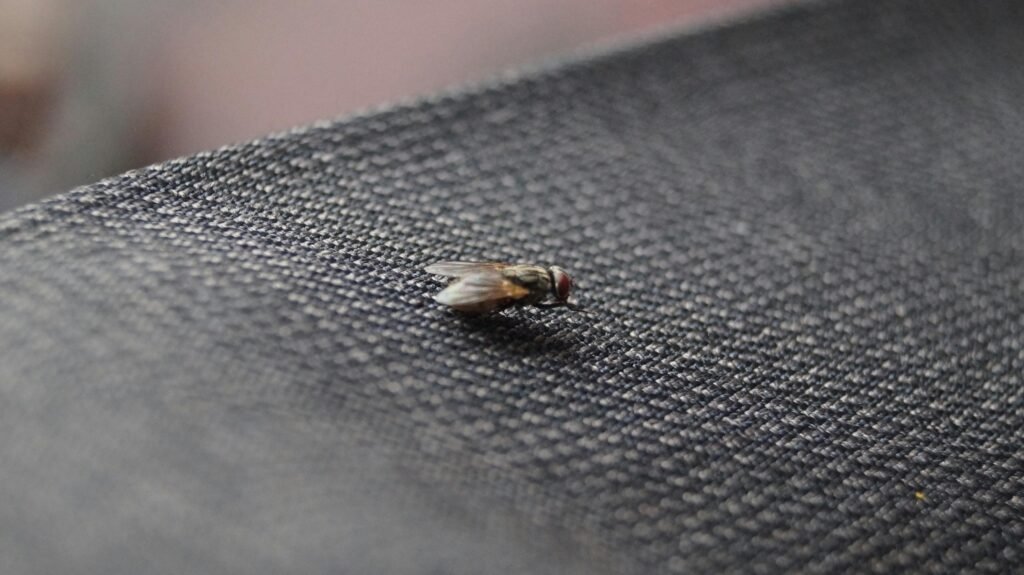Yellowjackets: Identification, Biology, Risks, and Control

The yellowjacket (Vespula spp. and Dolichovespula spp.) is one of the most well-known wasps across the world. Famous for their black-and-yellow patterns and notorious for their painful stings, yellowjackets are both beneficial predators and aggressive pests. Unlike the paper wasp (Polistes spp.) with its open umbrella-shaped nests, yellowjackets build large enclosed colonies, often hidden underground or inside wall voids.
Their ability to thrive in human-dominated environments—picnic areas, garbage bins, and backyards—makes them a frequent source of conflict with people. At the same time, they serve an ecological role by preying on flies, caterpillars, and other insects. This dual identity as both protector and pest means that yellowjackets require careful management rather than outright extermination.
Identification
Yellowjackets are often confused with honey bees (Apis mellifera) or hornets. Correct identification is important for control.
Size: Workers are 10–16 mm; queens are larger at 20 mm.
Color: Bright yellow with black bands.
Body shape: Smooth body with narrow waist, unlike the hairy body of bees.
Behavior: Rapid, aggressive flight patterns; often swarm around food.
Nests: Enclosed, papery structures. Commonly underground, but also in wall voids, attics, or tree cavities.
Distinctive feature: Ability to sting multiple times, unlike honey bees which sting once.
Species vary in appearance. For example, Vespula germanica (German yellowjacket) has three black spots on its face, while Vespula vulgaris (common yellowjacket) has an anchor-shaped facial mark.
Biology and Ecology
Nesting behavior
Colonies start in spring when an overwintered queen emerges.
Workers hatch in early summer and take over foraging duties.
By late summer, nests may contain thousands of individuals.
Colonies die in autumn, leaving only new queens to overwinter.
Diet
Adults feed on nectar, fruit juices, and sugary liquids.
Workers capture caterpillars, flies, and other insects to feed larvae.
They scavenge aggressively at human food sources like barbecues and garbage.
Reproduction
In late summer, reproductive males and new queens emerge.
After mating, males die, while fertilized queens seek protected overwintering sites such as soil cavities, tree bark, or human structures.
Ecological role
Act as biological control agents by reducing pest insect populations.
Serve as food for birds, mammals, and predatory insects.
Compete with pollinators like bees for nectar.
Global Distribution
Yellowjackets are native to the Northern Hemisphere but have spread globally.
North America: Vespula pensylvanica, Vespula maculifrons, Dolichovespula arenaria.
Europe: Vespula vulgaris and Vespula germanica are dominant species.
Asia: Various species widespread across temperate zones.
Australia & New Zealand: Invasive populations of V. germanica and V. vulgaris cause severe ecological problems, attacking honey bees and competing with native fauna.
Their ability to exploit food waste has made them highly successful in urban and suburban environments.
Risks and Damage
Human health risks
Stings cause immediate pain, swelling, and redness.
Multiple stings can be dangerous, particularly in allergic individuals (anaphylaxis risk).
Aggressive behavior around food makes outdoor dining hazardous.
Property risks
Nests inside walls or attics can damage insulation and wiring.
Noise from large nests may disturb homeowners.
Removal attempts without protection often result in serious stings.
Agricultural impact
In orchards and vineyards, yellowjackets damage ripening fruit.
Compete with honey bees for nectar, reducing pollination efficiency.
Attack hives of Apis mellifera, stealing honey and killing bees.
Signs of Infestation
Increased activity: Swarms of wasps around trash bins, compost, or outdoor meals.
Visible nests: Papery spheres in attics, wall voids, tree cavities, or underground holes.
Buzzing sounds: Coming from inside walls or ceilings.
Aggressive defense: Wasps attack when nests are approached within a few meters.
Fruit damage: Bite marks or hollowed spots on soft fruits like plums and grapes.
Control Methods
Prevention
Keep garbage sealed and outdoor areas clean.
Use wasp-proof lids on bins.
Seal entry points into buildings.
Harvest fruits promptly to avoid attracting wasps.
Physical control
Early-season nests (small, softball-sized) can be removed safely with protective clothing.
Underground nests may be destroyed by flooding with soapy water, though this carries risks.
Traps reduce worker numbers but rarely eliminate entire colonies.
Chemical control
Aerosol sprays kill workers on contact and can be applied at night to small nests.
Dust insecticides work well for underground nests.
Professionals use stronger products and protective suits for large or dangerous colonies.
Advanced Approaches
Integrated pest management (IPM): Combines monitoring, sanitation, and targeted control.
Eco-friendly deterrents: Peppermint oil and clove oil sprays deter nesting.
Biological controls: Research into pathogens like fungi and nematodes is ongoing.
Baiting systems: Protein baits laced with insecticides offer colony-level control in large infestations.
Public education: Teaching communities about wasp behavior helps reduce panic and risky DIY control.
Cultural and Historical Context
Yellowjackets have long been a symbol of aggression and persistence.
In ancient European folklore, wasps represented anger and retribution.
Indigenous cultures in North America respected yellowjackets as hunters.
In modern times, they are both despised as picnic pests and admired for their efficiency as predators.
Sports teams often use the yellowjacket as a mascot, emphasizing speed and ferocity.
This cultural duality reflects the insect’s real-world impact: both beneficial and dangerous.
FAQ Section
Q1: Are yellowjackets more dangerous than bees?
Yes. They can sting repeatedly and are more aggressive in defending their nests.
Q2: Can yellowjackets sting multiple times?
Yes. Unlike honey bees, they do not lose their stinger.
Q3: How long do yellowjacket colonies last?
One season, from spring to autumn. Only queens survive winter.
Q4: Why do yellowjackets swarm around food?
They are attracted to sugars and proteins, common in outdoor meals and garbage.
Q5: How can you safely remove a yellowjacket nest?
It is safest to hire a professional. If attempting DIY, do so at night with protective clothing and insecticide.
Q6: Do yellowjackets provide any benefits?
Yes. They reduce pest insect populations by feeding larvae with flies, caterpillars, and other insects.
Q7: What attracts yellowjackets the most?
Sugary drinks, ripe fruit, garbage, and meat scraps.
Q8: Are yellowjackets active at night?
No. They are diurnal but may be attracted to bright lights in the evening.
Final Thoughts
The yellowjacket (Vespula spp., Dolichovespula spp.) is one of the most recognizable wasps in the world—feared for its sting but respected for its role in controlling pest insects. Its adaptability, aggressive colony defense, and attraction to human food make it a recurring nuisance in urban, rural, and agricultural settings.
While yellowjackets do provide ecological benefits, they are often unwelcome near people. Preventive measures like proper waste management, sealing entry points, and early nest detection are essential. For established colonies, especially those in wall voids or underground cavities, professional pest control remains the safest and most effective option.
The long-term strategy is not to eliminate yellowjackets entirely but to reduce risks through integrated pest management (IPM)—balancing their ecological value with public safety.
Disclaimer
This article is for informational purposes only. Pest control laws and approved chemicals vary by country. For best results and legal safety, we strongly recommend contacting a licensed pest control professional in your local area. Always make sure that the pest control technician is properly certified or licensed, depending on your country’s regulations. It’s important to confirm that they only use approved products and apply them exactly as instructed on the product label. In most places in Europe, UK, or USA, following label directions is not just best practice—it’s the law.
Author Bio
Nasos Iliopoulos
BSc Agronomist & Certified Pest Control Expert
Scientific Director – Advance Services (Athens, Greece)
Licensed Pest Control Business – Ministry of Rural Development & Food (GR)
References
Wikipedia - Yellowjacket
Britannica - Yellowjacket


